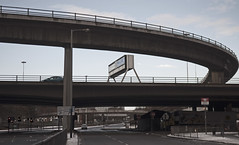Glasgow’s literacy and numeracy rates are amongst the lowest in Europe. Since it has a smaller population of readers to serve, Glasgow should invest less in schools.
Compared to the rest of Europe, a low proportion of people in Glasgow are healthy. The relatively small number of Glaswegians making use of their health indicates that Glasgow can invest less than the rest of Europe in health services.
Glasgow has the lowest employment rate in the UK. Therefore we should do less to invest in jobs in Glasgow than elsewhere.
Meanwhile, a very low proportion of Glasgow’s population is willing to use a bicycle for transport in the city. Therefore Glasgow should invest very little in providing for bicycle transport
One of my policy recommendations has been implemented by Glasgow City Council. Can you guess which one? That’s right. Glasgow City Council do not interpret a lack of healthy people as a reason not to invest in health services, but they would interpret a fall in the number of people cycling as a reason to cut funding for cycling infrastructure Glasgow.
(For some reason Glasgow City Council do not see the fact that Glasgow residents own a negligible number of electric cars, and indeed that fewer than half of all Glasgow households have access to a car of any kind, as a reason not to give those few who are rich enough to be able afford an electric car a gift of free storage space all over the city.)
It’s obvious enough that investment in literacy, health and jobs is not aimed at helping those who are already healthy educated people in employment, but at those who are not and who would benefit from being so — indeed, that low rates of literacy, health and employment are indicative of problems that politicians should be fixing. So why do people have such difficulty grasping the point of investing in enabling cycling?
I’ve written before about this bizarre idea so frequently cited by politicians (and incorporated into their absurd cost-benefit analysis model for transport infrastructure spending) and commentators these days — that somehow everybody has made a completely free choice, entirely uninformed by the environment around them, the options that have already been provided for, or the constraints imposed by the laws of physics; and that it’s the politician’s job simply to provide for what people have demonstrated is their choice. The absurdity of this position is encapsulated rather well in the fabricated Henry Ford quote beloved of management consultants and self-help book authors — “if I had asked people what they wanted, they would have said faster horses”.
Stupid though the idea is, I can understand why right-wing politicians and a libertarian government would want to pretend that everybody’s current transport use is the result of a completely free choice and so exactly reflects the modes of transport that we would most like to be using and which the government should provide for, and that therefore any government action which resulted in modal shift would be an unacceptable state intrusion into personal lifestyle choices. What really infuriates me is when campaigners — and it seems to be peculiar to cycling campaigners — hobble their own campaigns with the same stupid idea.
It is an idea that is closely tied up with those soft measures campaigns: it is the idea that there is no point in anybody asking for any kind of cycling infrastructure because there are currently too few cyclists for the request to be heard, therefore we need to focus on “more realistic” soft measures and encouraging more people to ride, until eventually there might be enough cyclists to make an effective lobby. Well if you’re designing your campaigns around policies to provide things for cyclists — to solve “the problems that cyclists face” — of course they will go unheard and ignored, just as a campaign to “solve the problems that cable car users face” would be a stupid way to go about getting a cable car built. Cyclists are “a curious, slightly nutty irrelevance“, and Cyclists campaigning on behalf of Cyclists doubly so. It’s why the Cycling Embassy was so desperately needed — a campaign for a new transport infrastructure for all, not the usual request for a bit more room for Cyclists; it’s why LCC’s Go Dutch campaign succeeds in attracting attention beyond the usual suspects; it’s why the name Cities Fit For Cycling suggests a good campaign, while the headline Save Our Cyclists didn’t.
If you think you can’t campaign for cycling infrastructure because there aren’t enough cyclists, you’re doing it wrong.














